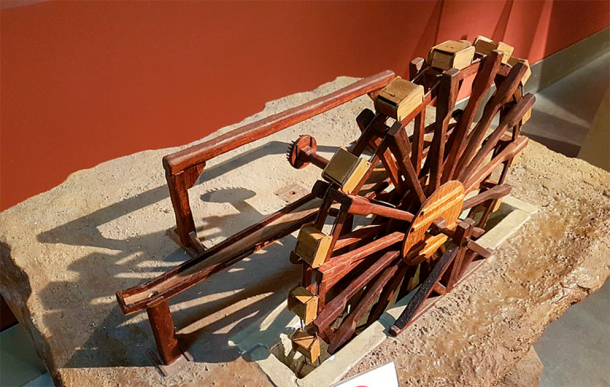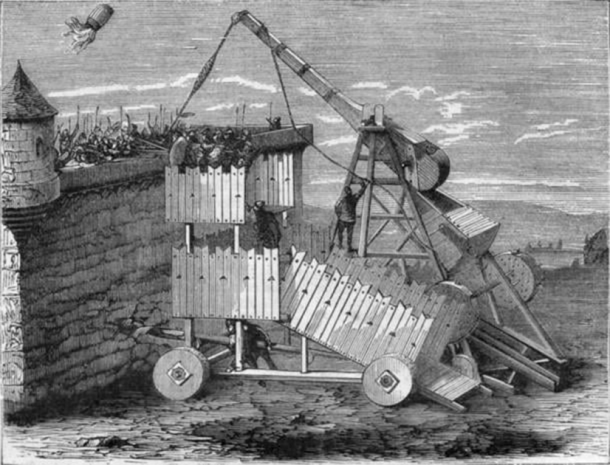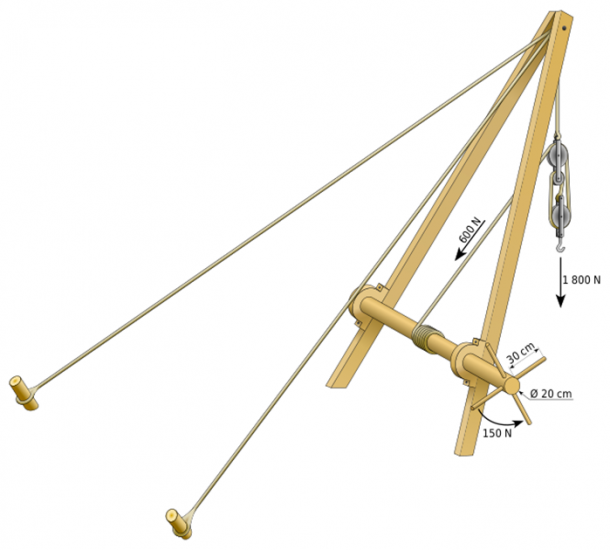Well perhaps. A frames are an obvious innovation along with water locks which surely allowed the Great pyramid to be built. The real genius of the Greeks was Pythagorus whose geometry allowed the advent of practical geometry which we recognize as engineering.
I do not think he invented it whole cloth, but he did organize a famous school which obviously serrved to gather engineering talent which has always been scarce on the ground unless actually catered to. Even then real talent remains scarce.
We actually produce an army of journey men able to modify and adjust the well known.
Top 5 Ancient Greek Inventions We Still Use Today
https://www.ancient-origins.net/artifacts-ancient-technology/greek-inventions-0018143?
Humanity has come a long way when it comes to crafty inventions, but some of the earliest innovative minds were the ancient Greeks. The ancient Greeks came up with several inventions that are still used now, though they may look a little different than they used to. Without these inventions, we certainly wouldn’t be as technologically advanced as we are today
1. Harnessing the Power of Water with Water Mills
In the 3rd century BC, ancient Greeks learned to harness the force of running water and developed the water mill, a significant innovation in the history of milling and an important step toward mechanization.
The water mill was powered by the force of running water, which turned a large wooden or stone wheel that was connected to a shaft or series of gears. As the wheel turned, it powered a system of gears and other mechanisms that could be used for a variety of purposes, such as grinding grain into flour, crushing olives to make oil, or sawing timber into planks.
The Greeks improved their early water mill designs by making future mills more efficient than before. They also developed sophisticated systems of water management including dams, aqueducts, and canals, which allowed them to control the flow of water and direct it to where it needed to go.
The water mill played an important role in the ancient Greek economy, providing a reliable source of power for many industries, including agriculture, mining, and manufacturing. It also helped to spur economic growth and innovation, as new technologies were developed to take advantage of its power.

Water mill from the 4th century BC in Greece. (reconstruction) at the Thessaloniki Technology Museum. (Gts-tg/CC BY-SA 4.0 )
2. Tracking Distance with the First Odometer
The odometer was an ancient Greek invention that was used to measure the distance traveled by a vehicle. The word "odometer" comes from the Greek words "odos," which means "road," and "metron," which means "measure."
While the odometer was first mentioned by Vitruvius in the 1st century BC, the first known odometer was created by the ancient Greek engineer Archimedes in the 3rd century BC. This early odometer was a simple device made of a wheel with teeth around its edge, which turned a series of gears that could display the distance traveled on a dial. The odometer was then mounted on a cart or chariot and was driven by the rotation of the wheels.

Archimedes created the first known odometer. ( Public Domain )
Archimedes' odometer was an important invention for ancient Greek commerce and transportation, as it allowed merchants and traders to accurately measure the distance traveled and better calculate the cost of goods and services. It also helped to improve the efficiency of transportation and logistics, as it allowed for more accurate estimates of travel times and distances.
Over time, the odometer was further developed by other Greek engineers, such as Heron of Alexandria , who created a more advanced version using a series of gears and chains to record distance traveled. The odometer was eventually adapted to also be used on horse-drawn carriages, bicycles, and automobiles. Today, it remains an important tool for measuring distance and speed in modern vehicles.
\
3. Hurling Projectiles with Ancient Catapults
The creation of the catapult in the 4th century BC revolutionized warfare by allowing soldiers to hurl large projectiles, such as stones and arrows, over long distances. The word "catapult" comes from the Greek word "kata-pultos," which means "downward stroke."
The first catapult was built around 400 BC by Dionysus the Elder. Early catapults were simple devices that used tension, torsion, or counterweights to launch projectiles. The most common type was the torsion catapult, which used twisted ropes or sinews to store energy before being released to launch the projectile.
Over time, the Greeks developed more advanced and sophisticated catapults. One of these advanced designs was the onager, a type of torsion catapult that used a sling to launch the projectile. Another was the ballista, a type of tension catapult that used twisted skeins of rope or sinews to launch large bolts or arrows.
One of the most popular catapults is believed to have been created by Archimedes, who used a series of complex levers and pulleys to launch massive stones over long distances in the siege of Syracuse in 214 BC. The catapult continued to be used throughout the ancient world and was later adapted by the Romans, who developed even more advanced and powerful versions that were used heavily in their military campaigns.

Thirteenth-century catapult for throwing Greek fire. ( Public Domain )
4. Water, Chimes, and Candles: Ancient Alarm Clocks
While the Greeks did not invent alarm clocks as we know them today, they did invent a similar concept in their time around the 4th century BC. Their early alarm clock was called the "water clock" or "clepsydra.” This device was essentially a container that was filled with water and had a small hole in the bottom. As the water slowly dripped out of the hole, it marked the passage of time using carvings within the bowl. It could also be used to wake someone up at a specific hour by pouring a set amount of water into a separate container that was fitted with a float to chime when it was full.

Diagram of a clepsydra clock, this type being an automaton or self-adjusting machine. Water enters and raises the figure, which points at the current hour for the day. Spillover water operates a series of gears that rotates a cylinder so that hour lengths are appropriate for today's date. The ancient Greeks and Romans had twelve hours from sunrise to sunset; since summer days are longer than winter days, summer hours were longer than winter hours. ( Public Domain )
Another device that was used as an alarm was a simple candle clock, which consisted of a candle marked with evenly spaced lines, each representing a specific interval of time. As the candle burned down, the lines would gradually disappear, allowing someone to tell the time. Some of these candles had nails or stones in them, so they would fall once the candle melted to a specific time and wake them up.
In addition to these timekeeping devices, the Greeks also used roosters and other animals as natural alarms, and would sometimes employ servants or slaves to wake them up at a specific time.
5. Easier Construction with the Crane
Tired of heavy lifting, the Greeks invented the first crane around 500 BC. The crane allowed the ancient Greeks to lift building blocks and statues that were typically too heavy to move by hand.
Early cranes were constructed with wood and had a long arm (called a jib) attached to a rotating base. The jib had a pulley system that allowed workers to lift and lower heavy objects. These cranes were operated by hand or sometimes by animals, such as oxen, which would pull ropes attached to the jib.

Drawing of ancient crane ("Three-pulley-crane"). A single man working the winch could raise loads of 150 kg (3 pulleys x 50 kg), assuming that 50 kg represent the maximum effort a man can exert over a longer time period. (Eric Gaba (Sting - fr:Sting)/ CC BY-SA 4.0 )
As the technology improved, cranes became more sophisticated. The Greeks figured out how to develop cranes that were powered by water, using hydraulic systems to lift heavy objects. They also invented the treadwheel crane, which used human or animal power to turn a large wheel that lifted and lowered objects.
The Greeks used cranes in many different ways, including in the construction of temples, palaces, and other large buildings. They also used cranes to move statues and other works of art. The most famous example of the use of cranes in Greek architecture is the construction of the Parthenon in Athens , which was built in the 5th century BC using cranes to lift and move the massive marble blocks that make up the temple.

Magnificent Parthenon in Athens built using early cranes. (Steve Swayne/ CC BY-SA 2.0 )
Modern Technology Thanks to the Greeks
The ancient Greeks were the epitome of innovation, and their legacy lives on today in many of the modern inventions we use. From the water mill, which revolutionized milling and led to the mechanization of industries, to the catapult, which transformed warfare and helped shape history, the Greeks were truly ahead of their time.
Top image: The catapult was a Greek invention. Source: ( Oguz Dikbakan /Adobe Stock)
By Lex Leigh

No comments:
Post a Comment